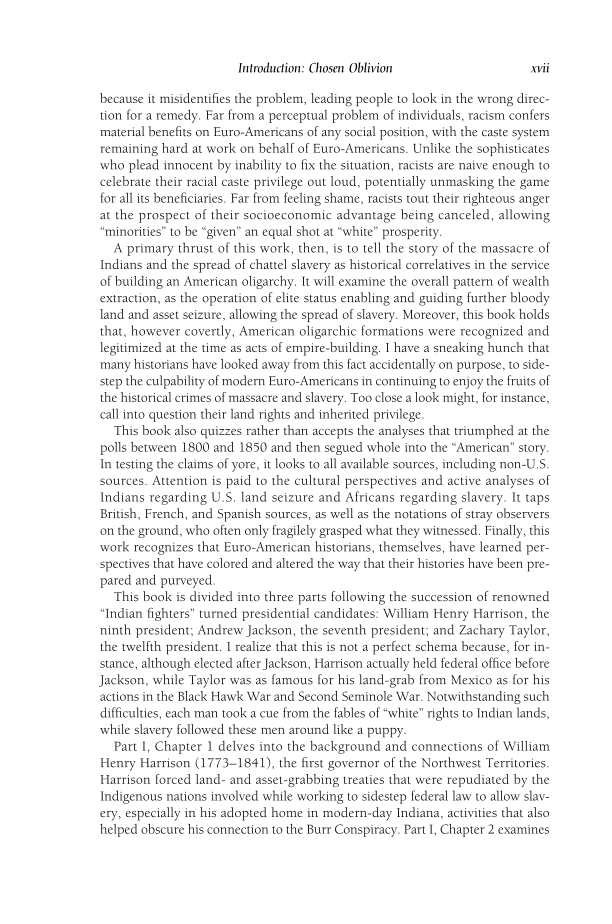because it misidentifies the problem, leading people to look in the wrong direc- tion for a remedy. Far from a perceptual problem of individuals, racism confers material benefits on Euro-Americans of any social position, with the caste system remaining hard at work on behalf of Euro-Americans. Unlike the sophisticates who plead innocent by inability to fix the situation, racists are naive enough to celebrate their racial caste privilege out loud, potentially unmasking the game for all its beneficiaries. Far from feeling shame, racists tout their righteous anger at the prospect of their socioeconomic advantage being canceled, allowing “minorities” to be “given” an equal shot at “white” prosperity. A primary thrust of this work, then, is to tell the story of the massacre of Indians and the spread of chattel slavery as historical correlatives in the service of building an American oligarchy. It will examine the overall pattern of wealth extraction, as the operation of elite status enabling and guiding further bloody land and asset seizure, allowing the spread of slavery. Moreover, this book holds that, however covertly, American oligarchic formations were recognized and legitimized at the time as acts of empire-building. I have a sneaking hunch that many historians have looked away from this fact accidentally on purpose, to side- step the culpability of modern Euro-Americans in continuing to enjoy the fruits of the historical crimes of massacre and slavery. Too close a look might, for instance, call into question their land rights and inherited privilege. This book also quizzes rather than accepts the analyses that triumphed at the polls between 1800 and 1850 and then segued whole into the “American” story. In testing the claims of yore, it looks to all available sources, including non-U.S. sources. Attention is paid to the cultural perspectives and active analyses of Indians regarding U.S. land seizure and Africans regarding slavery. It taps British, French, and Spanish sources, as well as the notations of stray observers on the ground, who often only fragilely grasped what they witnessed. Finally, this work recognizes that Euro-American historians, themselves, have learned per- spectives that have colored and altered the way that their histories have been pre- pared and purveyed. This book is divided into three parts following the succession of renowned “Indian fighters” turned presidential candidates: William Henry Harrison, the ninth president Andrew Jackson, the seventh president and Zachary Taylor, the twelfth president. I realize that this is not a perfect schema because, for in- stance, although elected after Jackson, Harrison actually held federal office before Jackson, while Taylor was as famous for his land-grab from Mexico as for his actions in the Black Hawk War and Second Seminole War. Notwithstanding such difficulties, each man took a cue from the fables of “white” rights to Indian lands, while slavery followed these men around like a puppy. Part I, Chapter 1 delves into the background and connections of William Henry Harrison (1773–1841), the first governor of the Northwest Territories. Harrison forced land- and asset-grabbing treaties that were repudiated by the Indigenous nations involved while working to sidestep federal law to allow slav- ery, especially in his adopted home in modern-day Indiana, activities that also helped obscure his connection to the Burr Conspiracy. Part I, Chapter 2 examines Introduction: Chosen Oblivion xvii
Document Details My Account Print multiple pages
Print
You have printed 0 times in the last 24 hours.
Your print count will reset on at .
You may print 0 more time(s) before then.
You may print a maximum of 0 pages at a time.

































































































































































































































































































































































































































































